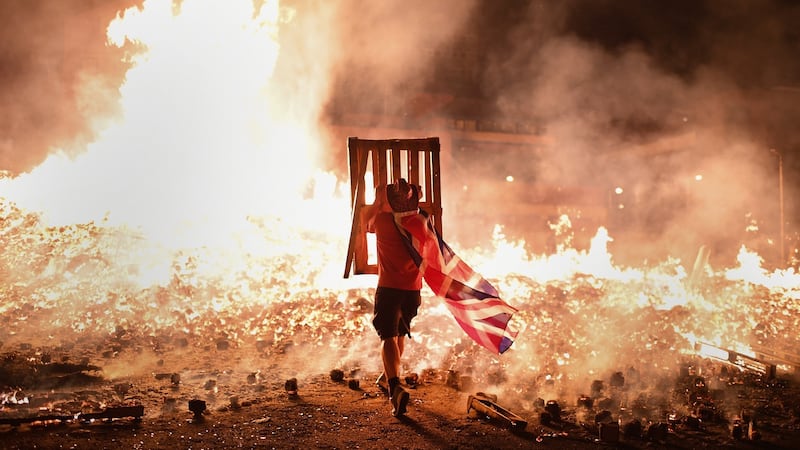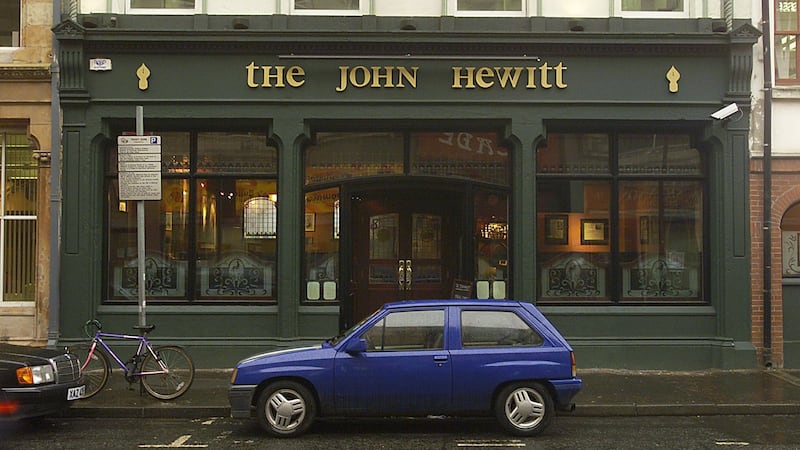It was FL Green, author of Odd Man Out, who wrote of Belfast: “Things seem to be constantly happening here and the city has an atmosphere that a creative writer needs”. Seventy years on, those words are still relevant and Belfast is a recurrent character in my stories – a bold, boozy, blustering and conflicted presence.
Growing up in the east Belfast suburb of Ballyhackamore, I was largely cocooned from the Troubles. The only anxiety I really experienced was a bomb scare when I was about seven. Ten years ago, I returned east to the inner-city area beside the Ravenhill Road. In spite of our supposed era of peace, I experienced the second bomb scare of my life here, though, in these tough streets, bomb scare is a misnomer; it was more of a bomb ignore, as most of us blithely chose not to answer our doors when the police tried to evacuate us.
I could say I moved here just for the cheap rent but I also knew it was a buzzing, edgy, urban hood. What writer wants to be marooned in the suburbs? All that they’re good for is solitude which is 50 per cent of writing, but the other 50 per cent requires excitement.
My street is moving with the times and is already ethnically diverse. Last year, there was the discovery of a Latvian crystal meth factory in the end house resulting in smashed windows and the wallside message, ‘Drugdealers Out’. The walls here are frequently used for community directives (the writer in me can at least appreciate the merit in writing on bricks rather than throwing them). Some of the newcomers do integrate into the mainly loyalist community – I recently saw a Roma boy beating away with two biros on a battered, red-white-and-blue drum - but the majority lead separate lives.
Compared to the rest of east Belfast, my district has always had more of a religious mix. The Catholic church round the corner was built on land bought from none other than an Orangeman. My street was even humorously named Pope’s Row by the locals. My neighbour, Reggie, told me that when paramilitaries from the Shankill arrived in the early ’70s to evict Catholics, he protected his Catholic neighbours by claiming they were Protestant.
This past summer, though, has been different from previous summers. Under the Union Jacks and UVF flags, new posters have appeared, tagged with ‘Stand Up Against Sectarianism’, depicting emotive images from the Troubles such as the Hyde Park bombing, the Kingsmill massacre and the Shankill Road bombing. All feature republican atrocities, so it’s ironic that posters purporting to be against sectarianism are used to promote it.
I don’t think remembrance of the past is necessarily a bad thing. ‘Lest we forget’ is enshrined in the Protestant mindset and every November 11th I think of my great-uncle Brian who was killed in a second World War airborne mission in his early twenties. My neighbours keep a lantern shining in their window for their loss and, while it may be fashionable to extol multiculturalism, there are times when there is a beauty in unity.

But something happened in my street last July that shocked me. On the Eleventh, the police dismantled a large bonfire from the nearby Cluan Place on the grounds of safety. I knew the decision would be viewed as a cleansing of Protestant culture from interface areas and I expected anger to erupt in the time-honoured tradition of urban frustration – rioting. But no.
Two days after the Twelfth, teenagers broke into the St Vincent de Paul school close to my house and set fire to it. I was out at the time but I heard afterwards that about 15 hooded and balaclavaed teens ran down our street. As I said, I was anticipating anger, especially in the sweltering heat of an unusually hot summer but I never expected anyone to try and burn down a Catholic school.
It’s impossible to tell if it’s an echo of the Troubles or a precursor of a new conflict, but I’m certain these teenagers, fired up with their own grievances, knew nothing about the religious mix of this area. There are only two ways to deal with history; either to ignore it completely, or look at all of it. The problem is that many Northern Irish people cherry-pick to prop up their own beliefs.
Though the urban tension fuels my writing, it’s hard to be a writer here. A Protestant friend said to me of the title of my short story collection, Catholic Boy, ‘Aren’t you excluding half your audience?’ I totally disagree; to write in a universal way about sectarianism transcends sectarian terms. Besides, who would really want a book called Cross-Community Boy?
It’s also not easy to survive financially in Belfast. The DUP and Sinn Féin have no desire to support the arts unless it subscribes to their own narrow view of culture, such as flute bands or trad sessions. They retain a fervent suspicion of free-thinking intellectualism since their power bases reside in streets like mine where strength is still determined by male brawn and, of course, teenagers in balaclavas. One thing you can bet your bottom euro on is that if we had a president, it wouldn’t be a poet, but rather a boxer or a celebrity chef.

Having said all that, Belfast does at least have a pub named after a poet, although the irony is that Hewitt was more into ‘The Planter and the Gael’ than the porter and the ale. As Michael Longley once joked to me, naming a pub The John Hewitt is like naming a brothel The Mother Theresa. To the other extreme, the George Best Hotel is scheduled to open soon. I can only imagine that the house special will be a champagne tower!
There was one more discovery I made this summer. I'd always thought that, with my quiet childhood in Ballyhackamore, our family had escaped the Troubles fairly unscathed. I recently heard, however, that a relative of my Dad's cousin had been shot dead in the early eighties. He was a farmer's son and was going about his work when he was targeted by the IRA. It just goes to show that in this small country nearly every family has undergone a loss. Even minor psychological scars run as deep here as bullet holes but, without them, our writing would not have its passion and depth.
Rosemary Jenkinson's latest collection of short stories, Catholic Boy, is published by Doire Press with ACNI support




















